How To Create a Better Online Course Experience (11 Actionable Tips)
 Platform Review
Platform Review

Learn a series of actionable tips that will help you improve the experience of your online courses. Keep your students and get better reviews.
Did you know that the average completion rate of an online course is 15% or less?
This means that people buy online courses but often don't even finish them.
Why?
Simply because they don’t enjoy the course.
This can have huge consequences for you as a course creator: if students don't take at least a significant part of your courses, there is a good chance that they won't be buying from you again in the future.
Despite these low completion rates, many course creators thrive in this business.
For example, I have been teaching online since 2016, and I currently have an instructor rating of around 4.5 stars on Udemy.
So it's possible to create courses that your students will love so much that they will not stop until they complete them.
But to get to that level of student satisfaction, you will need to apply a certain number of principles while building your course.
These principles fall roughly into two categories:
- you want to increase the perceived value of the course as much as possible. A higher perceived value means a higher degree of satisfaction from your students, giving them the feeling that buying the course was a good decision.
- you want to make the learning process itself as effective as possible, making it as easy as possible for your student to take, complete, and fully absorb your course
So, how to improve the experience of your online course?
The following principles will help you create an excellent online course experience that your students will love:
- Known your audience
- Use an effective pace
- Split up your course as much as possible
- Present with excitement
- Avoid unnecessary jargon to enhance clarity
- Provide extra written material
- Use different content formats
- Include quizzes
- Give Assignments
- Build a Community
- Organize regular doubt-clearing sessions
You can also check out all the free guides that you have available here at the Course Creator Academy by clicking on the Academy link on the top menu bar.
So without further ado, let's dive deep into all these principles.
1: Know Your Audience

It all starts with this base principle, it's the basis of everything, so don't overlook it or gloss over it.
You don’t just pick your favorite topic and launch an online course. Instead, you first need to validate your idea. You need to conduct some initial market research.
Like in any business, verify that what you’re going to teach matches an actual market need.
You might be tempted just to start recording your course, publish it in a marketplace, and wait to see what happens.
I can't recommend you that approach because there is a high risk that you will come up with a course that people don't want to buy.
Instead, I recommend that you do at least some quick analysis using tools like Google Trends or Ubersuggest and that you sign up for online forums where your audience hangs out, mingles in and starts understanding better what people are looking for.
This research is an ever-going process that is better done on a daily basis at least in the beginning.
Later on, you won't need to do daily research, but in the beginning, I recommend that you do so.
Passive research is great too, but you should engage actively with your future students on a one-by-one level and ask them what they need in a course.
This does not have to take as long as it sounds. 😉
Half an hour to an hour of research per day should be more than enough to give you a much better idea of what your students are looking for.
The amount of feedback and the huge number of ideas that you will get for your course is absolutely invaluable and well worth your time.
By doing this, the risk of creating a course that people don't want is way lower.
For example, you can use Typeform to create a survey and share it with your existing audience, or on Facebook groups, Quora, and anywhere else where your students hang out.
2: Use an Effective Pace

One of the biggest problems that many online courses have is the wrong information pace.
If you go too fast, you are going to end up losing a lot of people along the way that simply couldn't follow your fast teaching pace.
But if you teach your course too slowly, you risk ending up boring not only the faster-learning students but also any student in general, for that matter.
Remember that teacher you had in school that spoke in a boring tone that put all the class to sleep every time? You don't want to be that teacher.
One of the main reasons that students quit before completing the course is because they’re either overwhelmed with too much information or bored because of the slow pace.
You want to avoid both problems by striking a careful balance of always teaching at an optimum pace: not too fast and not too slow.
You want to speak at a slightly higher pace than you would do in a normal conversation, and you want to add more changes to your tone of voice than you normally would, but without exaggerating.
This takes time and practice, but it makes a huge difference to your students and is well worth learning how to master.
This tip is very closely related to our next tip.
3. Split up your course as much as possible

Besides the speed at which you actually speak, the way that you organize your course makes a huge difference to your students.
Did you know humans process information better in chunks?
In order to avoid overwhelming your students with too much information, you want to make sure that you split up your course into as many sections and lessons as it makes sense.
Each individual lesson should cover one and only one topic, from A to Z.
The lesson can be as small as 3 to 5 minutes, and it's better to avoid making lessons much larger than 15 minutes.
Larger lessons are a good sign that the lesson should have been split up into a couple of separate lessons and that the course is overall not very well thought out in terms of its structure.
Short lessons that only cover one thing at a time are a great way for your students to identify clearly what are the parts of the course that they are struggling with the most.
It's also a great way to reduce overwhelm and to encourage your students to keep taking the course, one 5-minute lesson at a time.
There is almost nothing more discouraging for a student to see that the next lesson is something like 21 minutes.
This will almost immediately result in thoughts like, "maybe I should continue the course tomorrow"...
4: Present With Excitement

A lot of the satisfaction that your students will associate with your course will be coming from the tone, the pace, and the overall "excitement" (for lack of a better word) that you used while presenting the course.
I know that presenting with an excited tone is easier said than done, especially for certain topics, and it does not come naturally to most people, including me.
You are, after all, an online teacher, not a comedian. 😉
But you don't need to go overboard with this.
If you simply decide to make a constant effort to pay close attention to your tone of voice and pace and make sure you avoid presenting in a monotonous tone, you will already make a huge positive difference to both you and your students.
Just by simply adding some more variety to your tone of voice, even if it's just a little bit, just by paying close attention and by being willing to work on this aspect of the course creation process, you should immediately see some positive results.
Any small change at all in the tone and pace of your voice is going to be tremendously helpful to your students in the sense that it will help them a lot to pay more attention to the course and learn more from it.
5: Avoid Unnecessary Jargon to Enhance Clarity

You might be tempted in your course to throw in a lot of advanced terms to not only highlight your expertise but it in the hope that it will make the course easier to understand for your students.
The problem is that it doesn't work like that. Unnecessary jargon and the overuse of complicated and advanced terms make the course that much harder to absorb by your students.
Of course, some topics are super technical, and some level of jargon is inevitable and even necessary, but in general, the language in your course should be simple as possible.
If there is a simpler term available to explain something, use that instead of the more complicated term. If you introduce some jargon or abbreviation in your language, make sure that you explain it thoroughly before continuing to use it throughout your course.
The idea that using a lot of jargon will make you look like an authority figure will quickly backfire on you.
Yes, your students will be somewhat impressed and be a bit more convinced that you do really know about your topic.
But they will also start thinking that even though you know the topic, you simply can't teach it to them well enough because you can no longer put yourself on their level and explain the topic in a way that is understandable to them.
If you provide a lot of written material or script your videos, an app like the Hemingway app is going to be super useful to check the reading level of your text.
6: Provide Extra Written Material

Most online courses are usually based around video, but the video should ideally not be the only form of content in your course.
If you want to enhance the course experience a lot for your students in a simple way and make them perceive your course as much more valuable, you can add extra material to your course besides just videos.
You can add descriptions with formatted text and messages to every lesson in your course and link to other resources available online.
For example, you can easily add rich-text descriptions to each lesson (formatted text with images) using our platform OnlineCourseHost.com.
Here is how to add a rich-text description to a lesson using the Edit Course screen:
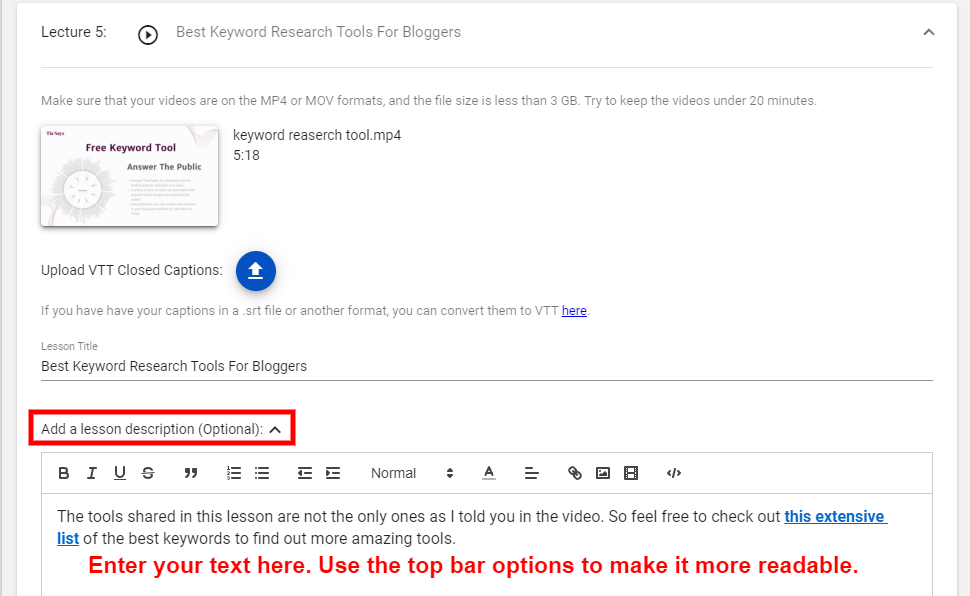
And if you want to add PDFs or other downloadable files to your course, you can also create a digital download lesson and add it to your course:

If you have a blog post or another document covering the same topic as some of your videos, you can create a PDF from it and include it in the course as extra material.
7: Use Different Content Formats
Besides adding written content to your course, adding other types of content to your course makes the course not only look more valuable but it also increases the chances that your students will actually consume the content and learn from it.
Here are some of the content types that you can add to your course; these are supported in the OnlineCourseHost.com platform:
- videos
- rich-text lessons (formatted text with links and images)
- extra downloadable resources like PDFs, spreadsheets, templates, etc.
- audio lessons
- PDF templates
- downloadable worksheets
8: Include Quizzes

This is maybe the most powerful tip on this list.
People don't like finishing boring tasks, but they certainly will spend time doing fun things. And students love quizzes because they’re easy and fun to do.
Plus, each correct answer boosts confidence. Quizzes encourage students to keep learning.
Adding a well-thought-out and relevant quiz after each video lesson or at least at the end of each section is going to increase a lot the perceived value of the course in the eyes of your students, and it does not take a lot of time to create.
You can add as many quizzes as you need in the course on the OnlineCourseHost.com platform by choosing the “Quiz” option:
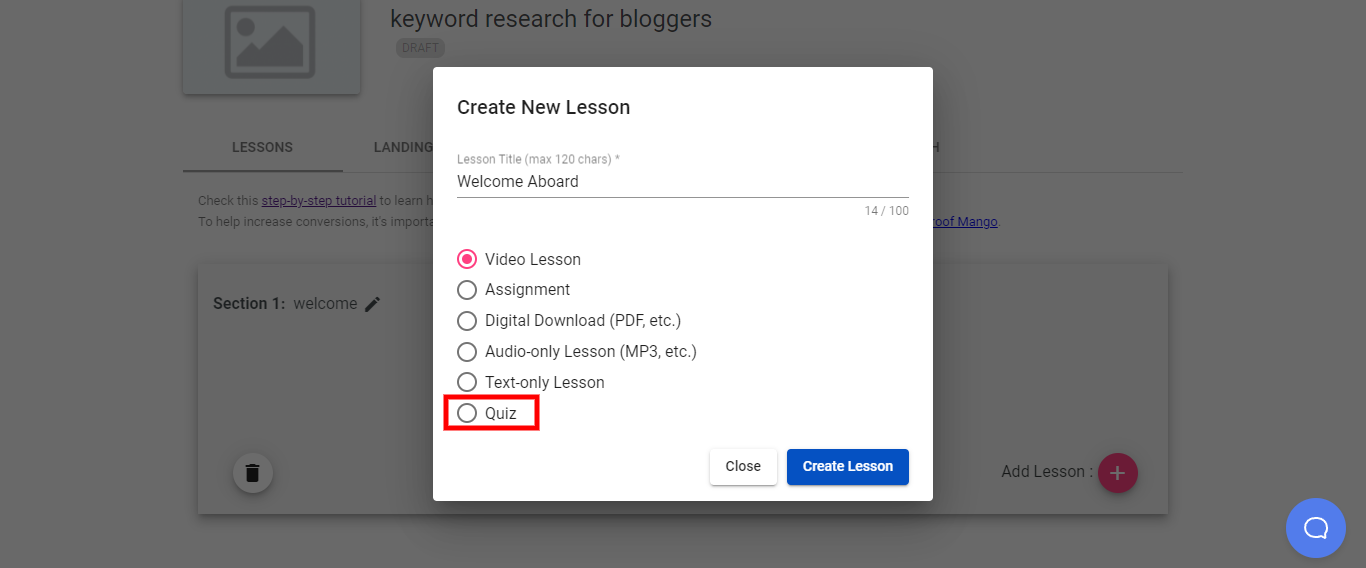
Students will access quizzes as a normal lesson on their dashboard, they will keep track of their progress and they will receive hints in case they don't guess the quiz the first time:
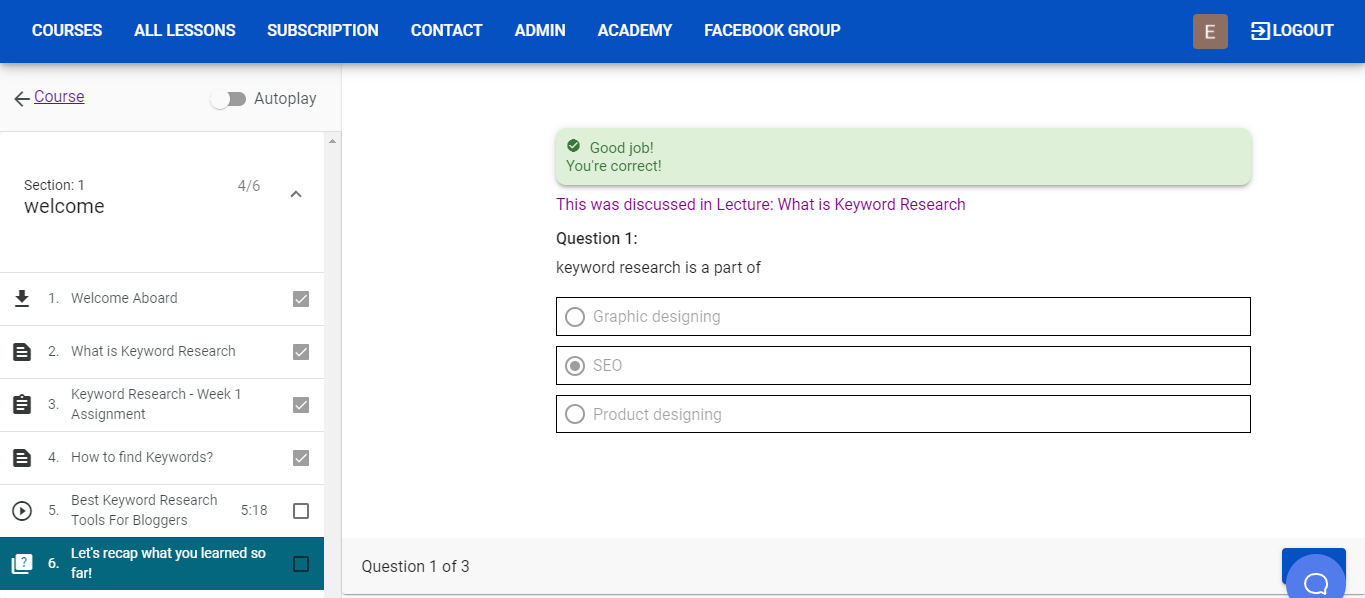
9: Give Assignments
Giving assignments is the most effective trick to encourage students to complete the lessons. Assignments provide hands-on experience and help to motivate your students to keep taking the course, as they will get that direct feedback from you that they can't get in video form.
So, how to create assignments that enhance your student's learning experience?
Simply try to create a mix of easy and complex questions that are challenging enough but not too difficult.
Once you have the assignment sheet prepared, upload it and add it to your course.
To create an assignment on OnlineCourseHost.com, simply choose the Assignment lesson type:
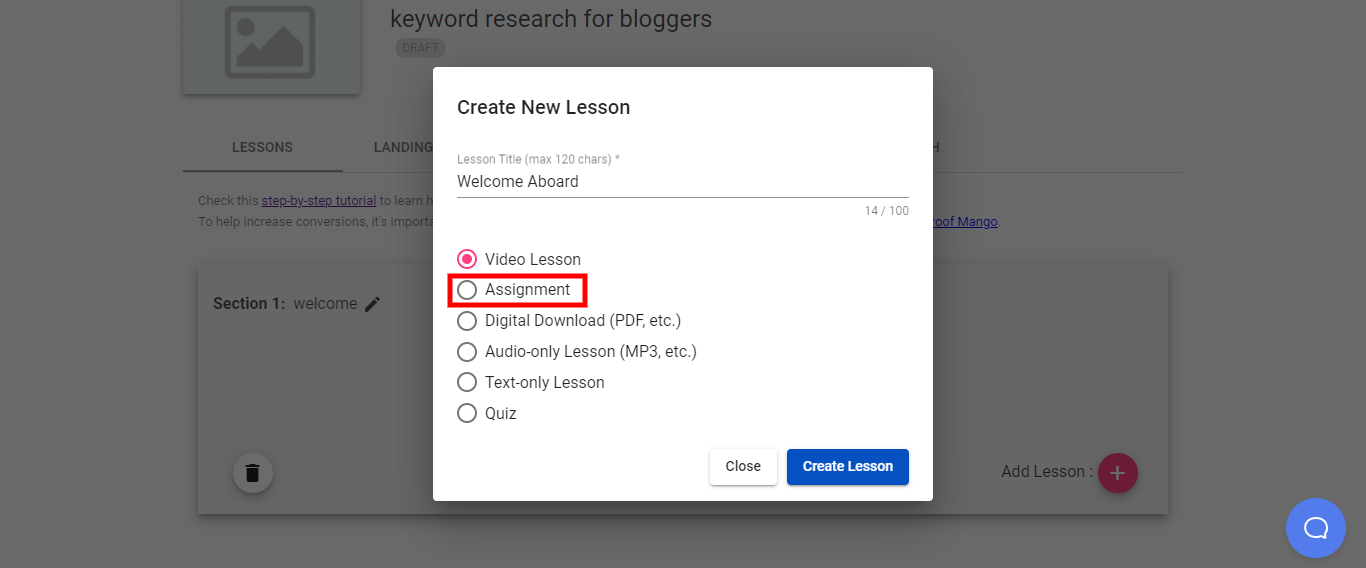
You can then add the assignment templates, the assignment instructions, and more:
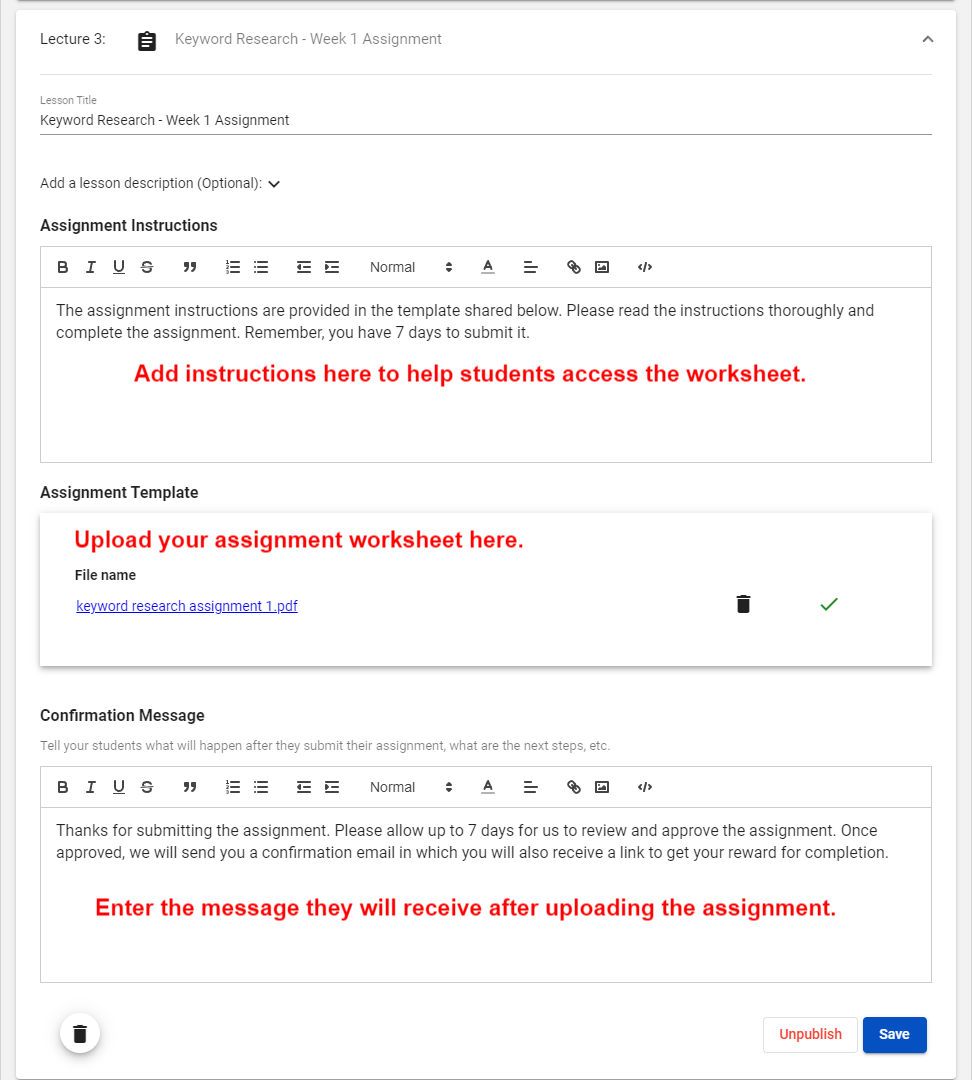
Students will then upload the worksheets on their student dashboard by clicking on the “Upload assignment” button:

10: Build a Community of Students

Always create a place where your students can learn and grow together.
This could be a Facebook Group, a Discord chat, Slack, a Subreddit that you own, or any other free online community software that allows you to create a community and moderate it as an admin.
You can then start discussions or assign group activities in the community and set and enforce the community rules that you choose.
If students don’t interact with each other, they might feel isolated and less motivated to continue taking the course.
Besides giving students that accountability and shared experience that they need, you can watch them closely in the community, see what questions they ask the most frequently, and collect insights to improve your course experience.
11: Organize Regular Doubt Clearing Sessions

One of the biggest fears of a student after paying for a course is that they won't get any access at all to the course creator anymore.
Regular doubt clearing sessions not only give your students the support they need to move forward but also benefit you in two ways:
- you get to build strong relationships with students and strengthen your brand image.
- you can then upsell to these more engaged students in the future.
So, organize Zoom meetings or Google Meet meetings and talk to your students regularly. It doesn't have to be every day; somewhere between once a week to once a month is ideal.
Clear doubts, tell your story, and build relationships.
Encourage students to put their questions below the lesson content. If you can't answer questions all the time, then hire someone to do it as your business grows, but make sure their questions get answered.
Keep nurturing your students even after the course is over via email, as they are the most likely candidates to purchase your next course.
Conclusion: How to Create a Better Online Course Experience?
In summary, here are the main things you can do to improve the experience of your online course:
- really get to known your audience
- make sure to use an effective pace, not too slow and not too fast
- always split up your course as much as possible into sections and lessons
- Try to present with some excitement, just a little bit goes a long way
- Don't complicate your language, avoid unnecessary jargon as much as possible
- Provide extra written material like spreadsheets, worksheets, summary sheets and other downloadable resources
- Use different content formats, like video, audio, rich text, or digital downloads
- always include quizzes, this is one of the most effective engagement techniques
- Hand out assignments, that you get to correct personally
- Build a community around your courses, and participate as an active community leader
- Organize regular doubt-clearing sessions, and ask your students to engage with each other and help each other out.
All these measures will contribute a lot to increasing student satisfaction, and help you make sure that you are providing your students with the best online course experience.
Now you already know how to make online classes more effective for students. So, go ahead and create an amazing course on OnlineCourseHost.com.
There are so many people waiting to learn from you!
I hope this guide helps you cut through the noise. More so, I hope it’s given you the confidence to start your online course journey.
If you are looking to ask any questions you need on online course creation, you can reach me here on my Facebook group:
Join the Course Creator Academy Facebook Group
If you would like to get notified when other guides and useful content on online course creation is available at the Academy, then you can join us here:
You can find many other guides like this in our Free Course Creators Academy
Here are some of our other popular articles and guides:
- How To Create An Online Course (In 15 Super-Practical Steps)
- How To Choose An Online Course Topic That Sells
- Affordable Online Course Equipment - Complete Practical Guide
- The Ultimate Online Course Launch Checklist
- How To Create The Perfect Online Course Sales Page
- Create A Powerful Brand For Your Online Courses (In 5 Steps)
- How To Sell Online Courses? The Ultimate Guide
- How To Promote Your Online Course - Complete Guide
- How To Handle Negative Reviews In Your Online Courses (and how to avoid them)
I hope you found this post helpful, let me know in the comments below what other topics you would like me to cover, or any questions that you have?
Thanks for reading… and enjoy the course creation process! 😉
Vasco Cavalheiro
OnlineCourseHost.com Founder & Online Course Creator
LinkedIn Facebook Page Facebook Group Twitter
You are welcome to ask me any questions in the comments below: 👇👇👇👇








 Start Here
Start Here Course Creation Journey Step by Step
Course Creation Journey Step by Step  Course Creation Software Reviews
Course Creation Software Reviews Online Course Marketing
Online Course Marketing Course Creation Tips & Tricks
Course Creation Tips & Tricks Course Equipment
Course Equipment Online Course Marketplaces
Online Course Marketplaces Revenue Reports
Revenue Reports Best Practices
Best Practices Frequently Asked Questions
Frequently Asked Questions Platform Reviews
Platform Reviews